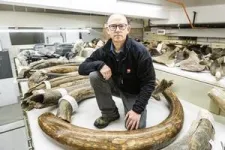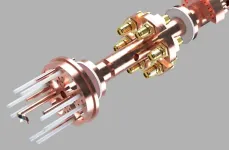(Press-News.org) Researchers have linked the travels of a 14,000-year-old woolly mammoth with the oldest known human settlements in Alaska, providing clues about the relationship between the iconic species and some of the earliest people to travel across the Bering Land Bridge.
Scientists made those connections by using isotope analysis to study the life of a female mammoth, named Élmayųujey'eh, by the Healy Lake Village Council. A tusk from Elma was discovered at the Swan Point archaeological site in Interior Alaska. Samples from the tusk revealed details about Elma and the roughly 1,000-kilometer journey she took through Alaska and northwestern Canada during her lifetime.
Isotopic data, along with DNA from other mammoths at the site and archaeological evidence, indicates that early Alaskans likely structured their settlements to overlap with areas where mammoths congregated. Those findings, highlighted in the new issue of the journal Science Advances, provide evidence that mammoths and early hunter-gatherers shared habitat in the region. The long-term predictable presence of woolly mammoths would have attracted humans to the area.
“She wandered around the densest region of archaeological sites in Alaska,” said Audrey Rowe, a University of Alaska Fairbanks Ph.D. student and lead author of the paper. “It looks like these early people were establishing hunting camps in areas that were frequented by mammoths.”
The mammoth tusk was excavated and identified in 2009 by Charles Holmes, affiliate research professor of anthropology at UAF, and François Lanoë, research associate in archaeology at the University of Alaska Museum of the North. They found Elma’s tusk and the remains of two related juvenile mammoths, along with evidence of campfires, the use of stone tools, and butchered remains of other game. All of this “indicates a pattern consistent with human hunting of mammoths,” said Ben Potter, an archaeologist and professor of anthropology at UAF.
Researchers at UAF’s Alaska Stable Isotope Facility then analyzed thousands of samples from Elma’s tusk to recreate her life and travels. Isotopes provide chemical markers of an animal’s diet and location. The markers are then recorded in the bones and tissues of animals and remain even after they die.
Mammoth tusks are well-suited to isotopic study because they grew throughout the ancient animals’ lives, with clearly visible layers appearing when split lengthwise. Those growth bands give researchers a way to collect a chronological record of a mammoth’s life by studying isotopes in samples along the tusk.
Much of Elma’s journey overlapped with that of a previously studied male mammoth who lived 3,000 years earlier, demonstrating long-term movement patterns by mammoths over several millennia. In Elma’s case, they also indicated she was a healthy 20-year-old female.
“She was a young adult in the prime of life. Her isotopes showed she was not malnourished and that she died in the same season as the seasonal hunting camp at Swan Point where her tusk was found,” said senior author Matthew Wooller, who is director of the Alaska Stable Isotope Facility and a professor at UAF’s College of Fisheries and Ocean Sciences.
The era in which Elma lived may have compounded the challenges posed by the relatively recent appearance of humans. The grass- and shrub-dominated steppe landscape that had been common in Interior Alaska was beginning to shift toward more forested terrain.
“Climate change at the end of the ice age fragmented mammoths’ preferred open habitat, potentially decreasing movement and making them more vulnerable to human predation,” Potter said.
Other contributors to the study included the University of Alaska Anchorage, University of Ottawa, McMaster University, University of Alaska Museum of the North, University of Michigan Museum of Paleontology, Adelphi University, University of Arizona, Hakai Institute and the Healy Lake Village Council.
END
Woolly mammoth movements tied to earliest Alaska hunting camps
2024-01-17
ELSE PRESS RELEASES FROM THIS DATE:
Researchers chronicle lifetime travels of a single woolly mammoth which wandered the north more than 14,000 years ago
2024-01-17
Attention editors: Embargoed by Science Advances until Wednesday, January 17th, 2 p.m. eastern
High resolution photos, background footage, video clips can be downloaded at this link: https://photos.app.goo.gl/Sn4unWFGHb5ULdeB9
Hamilton, ON, Jan. 17, 2024 – An international team of researchers from McMaster University, University of Alaska Fairbanks and the University of Ottawa has tracked and documented the movements and genetic connections of a female woolly mammoth that roamed the earth more than 14,000 years ago.
She travelled ...
New research tool seeks to accelerate hunt for cancer immunotherapy targets
2024-01-17
An innovative computational tool dubbed “SNAF” may help the research world bring the emerging promise of cancer immunotherapy to a wider range of patients, according to a study published Jan. 17, 2024, in Science Translational Medicine.
The research tool, called the Splicing Neo Antigen Finder (SNAF), was developed by a multidisciplinary team of researchers from Cincinnati Children’s and the University of Virginia. The project was led by Guangyuan Li, PhD, and Nathan Salomonis, PhD, both with the Division of Biomedical Informatics at Cincinnati ...
SARS-CoV-2 can infect dopamine neurons causing senescence
2024-01-17
A new study reported that SARS-CoV-2, the virus that causes COVID, can infect dopamine neurons in the brain and trigger senescence—when a cell loses the ability to grow and divide. The researchers from Weill Cornell Medicine, Memorial Sloan Kettering Cancer Center and Columbia University Vagelos College of Physicians and Surgeons suggest that further research on this finding may shed light on the neurological symptoms associated with long COVID such as brain fog, lethargy and depression.
The findings, published in Cell Stem Cell on Jan. 17, show that dopamine neurons infected with SARS-CoV-2 stop working and send out chemical signals that cause ...
The metalens meets the stars
2024-01-17
Metalenses have been used to image microscopic features of tissue and resolve details smaller than a wavelength of light. Now they are going bigger.
Researchers at the Harvard John A. Paulson School of Engineering and Applied Sciences (SEAS) have developed a 10-centimeter-diameter glass metalens that can image the sun, the moon and distant nebulae with high resolution. It is the first all-glass, large-scale metalens in the visible wavelength that can be mass produced using conventional CMOS fabrication technology.
The ...
New U of A-based study to examine very rare adverse events linked to COVID-19 vaccines
2024-01-17
EDMONTON — A University of Alberta professor is co-leading a new international vaccine safety network to examine why some people who received a COVID-19 vaccine experienced very rare adverse events associated with the vaccine.
The International Network of Special Immunization Services (INSIS), based at the U of A, is a consortium of academic medical centres around the world coming together to study very rare adverse events after vaccination. An adverse reaction is considered very rare when it affects less than .001 per cent of the population.
“The bar for safety with vaccines is very high because we’re giving them ...
$24 million grant to extend Study of Healthy Aging in African Americans (STAR)
2024-01-17
Researchers at UC Davis Health and Kaiser Permanente Division of Research have received a $24 million grant from the National Institute on Aging, part of the National Institutes of Health (NIH), to continue the Study of Healthy Aging in African Americans (STAR) for an additional five years.
STAR, which launched in 2017, follows a group of approximately 750 older adults to understand how behaviors and lifestyle may increase the risk of Alzheimer’s disease and related dementias for Black and African Americans. The study ...
Metastatic breast cancer treatments have aided decline in deaths, Stanford Medicine-led study finds
2024-01-17
Deaths from breast cancer dropped 58% between 1975 and 2019 due to a combination of screening mammography and improvements in treatment, according to a new multicenter study led by Stanford Medicine clinicians and biomedical data scientists.
Nearly one-third of the decrease (29%) is due to advances in treating metastatic breast cancer —a form that has spread to other areas of in the body and is known as stage 4 breast cancer or recurrent cancer. Although these advanced cancers are not considered curable, women with metastatic disease are living longer than ever.
The analysis helps cancer researchers assess where to focus future efforts and resources.
“We’ve ...
Aberrant RBMX expression relevant for cancer prognosis and immunotherapy response
2024-01-17
“In the future, targeting of RBMX may be a novel method in cancer therapy.”
BUFFALO, NY- January 17, 2024 – A new research paper was published in Aging (listed by MEDLINE/PubMed as "Aging (Albany NY)" and "Aging-US" by Web of Science) Volume 16, Issue 1, entitled, “Aberrant RBMX expression is relevant for cancer prognosis and immunotherapy response.”
Cancer accounts for the highest rates of morbidity and mortality worldwide. RNA binding motif protein X-linked (RBMX) is a nuclear ...
Higher measurement accuracy opens new window to the quantum world
2024-01-17
A team at HZB has developed a new measurement method that, for the first time, accurately detects tiny temperature differences in the range of 100 microkelvin in the thermal Hall effect. Previously, these temperature differences could not be measured quantitatively due to thermal noise. Using the well-known terbium titanate as an example, the team demonstrated that the method delivers highly reliable results. The thermal Hall effect provides information about coherent multi-particle states in quantum materials, based on their interaction with lattice vibrations (phonons).
The laws of quantum physics apply to all materials. However, in so-called ...
National collaborative for health equity roundtable: a call for unity and the power of racial healing
2024-01-17
A new Roundtable discussion in the peer-reviewed journal Health Equity explores the results of a poll conducted by the National Collaborative for Health Equity (NCHE), called the “Heart of America Annual Survey.” The survey found that more than 80% of respondents want a national leader that unifies rather than divides us, suggesting that there is a readiness in the country to put polarization and division behind us so that we can solve our collective and common challenges and problems. Click here to read the Roundtable now.
Moderating ...










